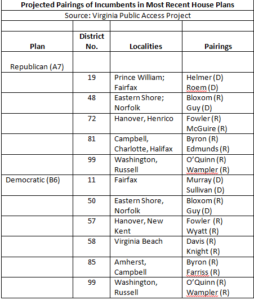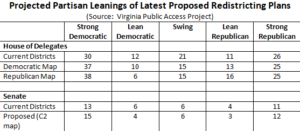 by Dick Hall-Sizemore
by Dick Hall-Sizemore
Most General Assembly incumbents are resting easier. The Democrat and Republican map drawers took their guidance from the Virginia Redistricting Commission seriously and drew district lines putting most incumbents in districts with no other incumbents.
As discussed in an earlier post, the Commission members interpreted Virginia Code language as requiring it to protect incumbents as much as possible. That language prohibits the production of plans that, on the whole, “unduly favor or disfavor” a political party.
The extent to which the lines were drawn to protect incumbents is not obvious on the maps that have been made public. However, the map drawers, while presenting their recommendations on Saturday to the Commission, were able to turn on an overlay in their software that showed the precise location of each incumbent’s residence. A large number of those little dots were very close to district lines or nestled in an area that suddenly bulged from one district into an adjacent district.
When questioned about the shapes of some districts, the map drawers explained that they were needed to protect incumbents. No one objected. One Commission member, however, did express some concern about an appendage, extending from a district near Lynchburg, which was used to separate incumbent Delegates Kathy Byron and Matt Farriss into separate districts. It was not that she was objecting to its use, only that it seemed too obvious. The map drawer allayed her fears by responding that it would be easy to transfer a precinct from an adjoining district to the appendage thus “smoothing out” the boundary for Farriss’ district without having to disrupt the boundaries of any other district. With a few key strokes on his computer, the change was made. (For anyone wanting to see these details, the video for the October 2 meeting can be found here, although it usually takes the staff a day or so to load the recording from the live stream.)
Fortunately, the Virginia Public Access Project has partially filled this information void by providing maps showing those districts in which two or more incumbents reside for each iteration of Commission maps. The discussion below relies on that data.
The most recent Republican map lumps only 20 incumbents into a district containing two incumbents and the latest Democratic map lumps 24. See table below. In contrast, in two earlier maps, drawn before the map drawers had been instructed to take incumbent addresses into account, the Democratic map drawer had 37 incumbents in districts with two or more incumbents, while the Republican map drawer had 34 incumbents in such districts. (Both plans even had districts with three incumbents.)

The map drawers also were able to protect more Senate incumbents once they were given the green light. Earlier Senate maps had paired either 14 (Republican map) or 18 (Democratic map) incumbents. The “integrated” map shown early last week (labeled C2) showed only 10 incumbents paired and, of those, three had indicated they did not plan to run for reelection in 2023, resulting in the pairing of only four incumbents. In Northern Virginia, the pairings were Democrats Saslaw/Marsden and Boysko/Howell, but, according to media reports, Saslaw and Howell were planning to retire and not run for reelection. (That came as a surprise to me.) In the Lynchburg area, Republican Sens. Newman and Peake were placed in the same district, but Newman announced to the Commission earlier in the summer that he would not be running for reelection. That left Kiggans (R) and Lewis (D) paired in an Eastern Shore/Norfolk district and Edwards (D) paired with Sutterlein (R) in the Roanoke area. (No analysis is available yet for the two Senate plans unveiled on Saturday.)
One result of the redistricting will be a significant number of open districts. Both the latest Republican and Democratic House plans show 16 open seats. The latest Senate plan for which there is an analysis shows five open seats. It should be noted that those numbers exaggerate the effect of redistricting. The analysis of the House includes only candidates who will be on the ballot this November. Several incumbents are not on the ballot due to retirement, primary defeats, or choosing to run for statewide office. Therefore, after November, some of the districts now shown as open on the redistricting maps will have incumbents.
In trying to comply with the prohibition against “unduly favoring or disfavoring” either party, the Commission members and their map drawers paid some attention to prior voting patterns in the proposed districts, although not as much as was paid to protecting incumbents. VPAP has analyzed the partisan leanings of the proposed maps and the summary of that analysis is shown in the table below. In comparing the two House maps, it is apparent why both sides wanted their own map drawers.


Leave a Reply
You must be logged in to post a comment.